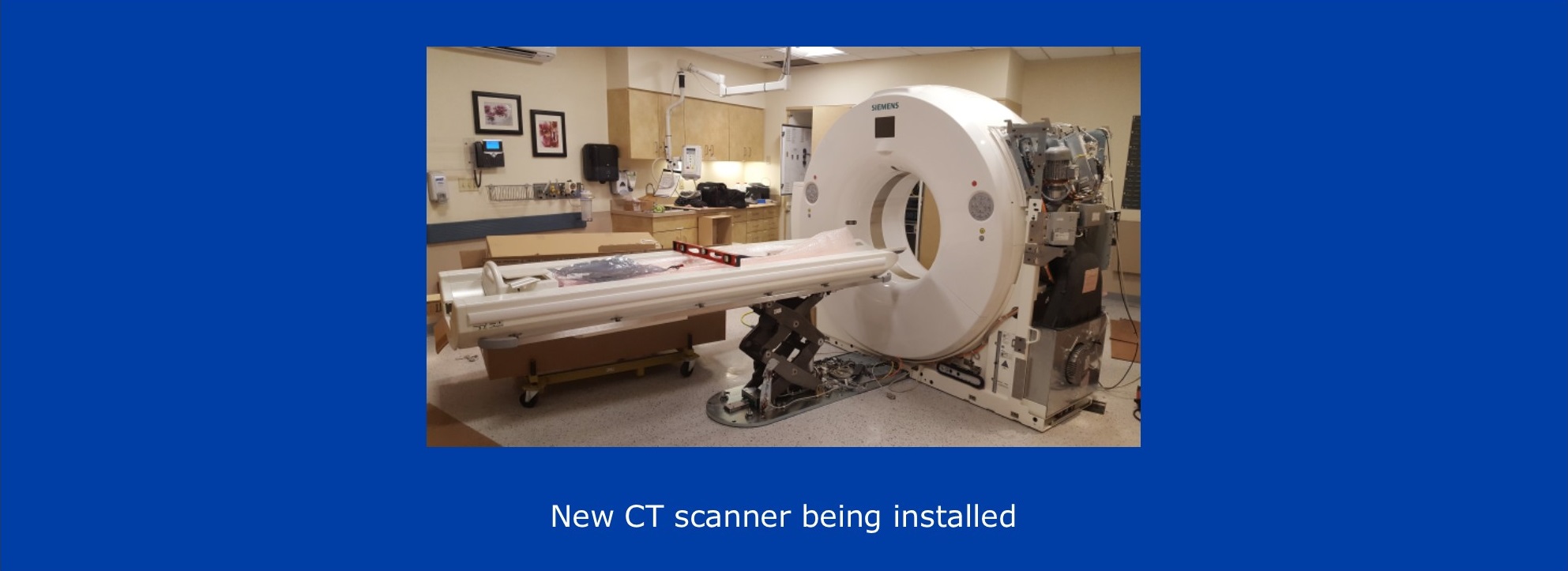
Last year’s MRI (Magnetic Resonance Imaging) upgrade in the Department of Radiology has enabled the department to acquire higher quality scans in less time, resulting in a more satisfying patient experience while increasing access to services through the creation of an additional 40 appointments slots per week—all without adding additional resources. Director of Radiology Brian McIntosh, BS, RT(R), CRA, considers this to be “a great example of applying the Partners 2.0 philosophy to the practice of medical imaging.” This year, the department has turned its attention to CT, hoping for similar results.
“We are replacing an older 16-slice scanner, which was state-of-the-art in the early 2000s,” McIntosh says. The new scanner will be a Siemens Definition AS128. “This matches the capabilities of our other scanner, in terms of speed, image quality and software capabilities such as dose reduction and metal artifact reduction. It will allow us to perform any scan on any patient on either scanner. This is something we can’t do today because of the limitations of the older scanner,” McIntosh explains. He further notes that the older machine has been severely underutilized for some time. “The 16-slice scanner has only been used for CT-guided interventional procedures or if the 128-slice scanner was being serviced or if there was such an overflow of cases that there was no other choice to keep up with production.”
The process to replace the old scanner took just over a month. First, the existing scanner had to be de-installed, followed by electrical and HVAC upgrades to the room to handle the higher heat output and electrical demands of the more sophisticated equipment. New flooring provides for a fresh look to the room, and the cabinetry housing the equipment generators was rebuilt to size. Upon installation of the new scanner, staff received applications training from the vendor, which was more of a “reinforcement of knowledge in the use of the equipment and its various software applications, since we have the same technology in the other room,” McIntosh notes.
When asked about how the new scanner will benefit the department, McIntosh cited several examples. “First, we hope to completely eradicate the daily bottlenecks that occur as a result of trying to squeeze all outpatients, emergency patients and inpatients through one scanner.” The department is now able to designate one scanner primarily for CT-guided interventional procedures and outpatient appointments, while the other scanner can be primarily designated for inpatients and Emergency Department patients.
However, McIntosh says, “We are not limited by scanner technology anymore. Even though we will have designated scanners for the different patient types, we also have complete flexibility to utilize any scanner for any exam on any patient in response to volume swells. For example, if the ED is really busy, we can easily bring those patients to the outpatient scanner as well.”
ED volume continues to grow, and approximately 56 percent of all CT scans performed today are add-on patients from the ED. “You can see how an equally capable scanner will allow for more timely throughput without impacting the outpatient schedule, or vice versa” McIntosh says. “We expect a quicker turnaround for ED patients, and outpatient delays should become minimized.”
Another benefit is the expected increase in outpatient access by doubling the number of outpatient appointment slots offered per day. “Annually, we estimate 4,000 to 7,000 new slots can be created, depending on the Interventional case-load. CT-guided interventional slots are longer than the standard 15-minute appointment slot, so one procedure can take as many as 8 appointment slots when scheduled,” McIntosh clarifies.
As part of the replacement of the 16-slice scanner, the department also added dose reduction software and metal artifact reduction software to both scanners. CT dose reduction techniques are part of the Joint Commission Diagnostic Imaging Standards, and metal artifact reduction software minimizes “streaking” seen on scans, which compromise the quality of imaging. “Both scanners now have all the same software and have equal capabilities,” says McIntosh.
There are also benefits to the staff. “They will now be working consistently out of two rooms,” says McIntosh. “It allows for a better workflow with the proper distribution of patients to both scanners. That translates to better care and a better work environment for the staff.” It also allows for the same imaging protocols on either scanner.
“This is very similar to our MRI experience… increased access, better throughput and the clinical benefits are noteworthy—higher quality imaging, faster scan times and a better patient experience— and all this is possible without additional resources,” says McIntosh.
McIntosh closes by crediting Chief of Radiology, Stephen Ledbetter, MD, and CT Medical Director Aaron Sodickson, MD, along with Radiology Program Manager Rakesh Kannan and CT Supervisor and Jessica Lorusso for their oversight, input and planning for the equipment selection and installation. “They deserve so much of the credit for the success of this project. It is their expert opinions and detailed contributions that have allowed this implementation to go so well. Our patients will benefit for years to come because of their effort, and the work of the CT staff who perform the exams.”

Looking for more news from BWFH? Go to News to find articles about health, updates to our programs and services and stories about staff and patients.
Go to News